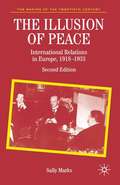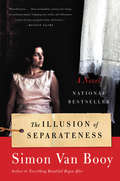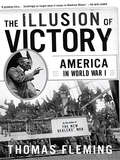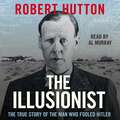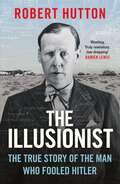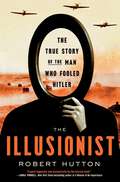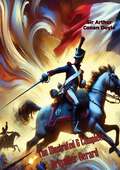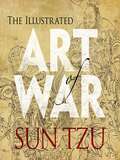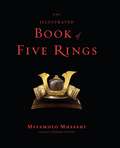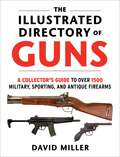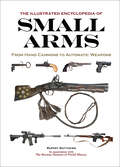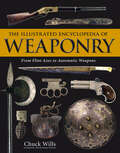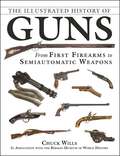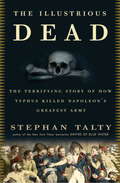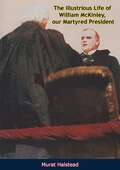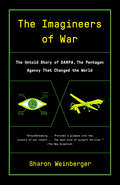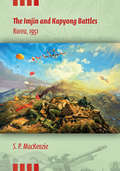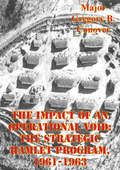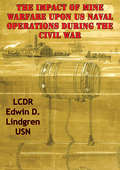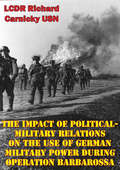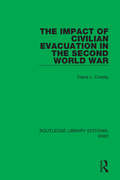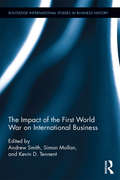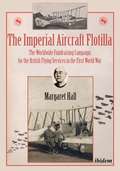- Table View
- List View
The Illusion of Peace: International Relations in Europe, 1918–1933 (Making Of The Twentieth Century Ser.)
by Sally MarksSally Marks provides a compelling analysis of European diplomacy between the First World War and Hitler's advent. She explores in clear and lively prose the reasons why successive efforts failed to create a lasting peace in the interwar era. Building on the theories of the first edition - many of which have become widely accepted since its publication in 1976 - Marks reassesses Europe's leaders of the period, and the policies of the powers between 1918 and 1933, and beyond. Strongly interpretative and archivally based, The Illusion of Peace examines the emotional, ethnic, and economic factors responsible for international instability, as well as the distortion of the balance of power, the abnormal position of the Soviet Union, the weakness of France and the uncertainty of her relationship with Britain, and the inadequacy of the League of Nations. In so doing, the study clarifies the complex topics of reparations and war debts and challenges traditional assumptions, concluding that widespread western devotion to disarmament and dedication to peace were two of several reasons why democratic statesmen could not respond decisively to Hitler's threat. In this new edition Marks also argues that the Allied failure to bring defeat home to the German people in 1918-19 generated a resentment which contributed to interwar instability and Hitler's rise. This highly successful study has been thoroughly revised and updated to reflect the latest scholarship. Now in its second edition, it remains the essential introduction to the tense political and diplomatic situation in Europe during the interwar years.
The Illusion of Separateness
by Simon Van BooyIn The Illusion of Separateness, award-winning author Simon Van Booy tells a harrowing and enchanting story of how one mans act of mercy during World War II changed the lives of strangers, and how they each discover the astonishing truth of their connection. Whether they are pursued by Nazi soldiers, old age, shame, deformity, disease, or regret, the characters in this utterly compelling novel discover in their, darkest moments of fear and isolation that they are not alone, that they were never alone, that every human being is a link in an unseen chain. The Illusion of Separateness intertwines the stories of unique and compelling characters who--through seemingly random acts of selflessness--discover the vital parts they have played in each others lives.
The Illusion of Victory: America in World War I
by Thomas FlemingIn this sweeping historical canvas, Thomas Fleming undertakes nothing less than a drastic revision of our experience in World War I. He reveals how the British and French duped Wilson into thinking the war was as good as won, and there would be no need to send an army overseas. He describes a harried president making speech after speech proclaiming America's ideals while supporting espionage and sedition acts that sent critics to federal prisons. And he gives a harrowing account of how the Allies did their utmost to turn the American Expeditionary Force into cannon fodder on the Western Front. Thoroughly researched and dramatically told, The Illusion of Victory offers compelling testimony to the power of a president's visionary ideals-as well as a starkly cautionary tale about the dangers of applying them in a war-maddened world.
The Illusionist: The True Story of the Man Who Fooled Hitler
by Robert HuttonCairo, 1942: If you had asked a British officer who Colonel Clarke was, they would have been able to point him out: always ready with a drink and a story, he was a well-known figure in the local bars. If you then asked what he did, you would have less success. Those who knew didn't tell, and almost no one really knew at all.Clarke thought of himself as developing a new kind of weapon. Its components? Rumour, stagecraft, a sense of fun. Its target? The mind of Erwin Rommel, Hitler's greatest general. Throughout history, military commanders have sought to mislead their opponents. Dudley Clarke set out to do it on a scale no one had imagined before. Even afterwards, almost no one understood the magnitude of his achievement. Drawing on recently released documents and hugely expanding on the louche portrait of Clarke as seen in SAS: Rogue Heroes, journalist and historian Robert Hutton reveals the amazing story of Clarke's A Force, the invention of the SAS and the Commandos, and the masterful hoodwinking of the Desert Fox at the battle of El Alamein. The Illusionist tells for the first time the dazzling tale of how, at a pivotal moment in the war, British eccentricity and imagination combined to thwart the Nazis and save innumerable lives - on both sides.
The Illusionist: The True Story of the Man Who Fooled Hitler
by Robert HuttonCairo, 1942: If you had asked a British officer who Colonel Clarke was, they would have been able to point him out: always ready with a drink and a story, he was a well-known figure in the local bars. If you then asked what he did, you would have less success. Those who knew didn't tell, and almost no one really knew at all.Clarke thought of himself as developing a new kind of weapon. Its components? Rumour, stagecraft, a sense of fun. Its target? The mind of Erwin Rommel, Hitler's greatest general. Throughout history, military commanders have sought to mislead their opponents. Dudley Clarke set out to do it on a scale no one had imagined before. Even afterwards, almost no one understood the magnitude of his achievement. Drawing on recently released documents and hugely expanding on the louche portrait of Clarke as seen in SAS: Rogue Heroes, journalist and historian Robert Hutton reveals the amazing story of Clarke's A Force, the invention of the SAS and the Commandos, and the masterful hoodwinking of the Desert Fox at the battle of El Alamein. The Illusionist tells for the first time the dazzling tale of how, at a pivotal moment in the war, British eccentricity and imagination combined to thwart the Nazis and save innumerable lives - on both sides.
The Illusionist: The True Story of the Man Who Fooled Hitler
by Robert HuttonThe astonishing story of how in 1942, in Egypt, Colonel Dudley Clarke's ingenious "A Force" thwarted the Nazis while inventing a whole new playbook of military deception. Cairo, 1942: If you had asked a British officer who Colonel Clarke was, they would have been able to point him out. Always ready with a drink and a story, Clarke was a well-known figure in Cairo social circles and nightlife. If you then asked what he did, you would have less success. Those who knew didn't tell—and almost no one really knew at all. Clarke thought of himself as developing a new kind of weapon. Its components? Rumor, stagecraft, a sense of fun. Its target? The mind of Erwin Rommel, Hitler's greatest general. Throughout history, military commanders have sought to mislead their opponents. Dudley Clarke set out to do it on a scale no one had imagined before. Even afterwards, almost no one understood the magnitude of his achievement. Drawing on recently released documents and hugely expanding on the louche portrait of Clarke as seen in SAS: Rogue Warriors, journalist and historian Robert Hutton reveals the amazing story of Clarke's "A Force,&” the invention of the SAS and the Commandos, and the masterful hoodwinking of the Desert Fox at the battle of El Alamein. The Illusionist tells for the first time the dazzling tale of how, at a pivotal moment in the war, British eccentricity and imagination combined to thwart the Nazis and save innumerable lives—on both sides.
The Illustrated & Complete Brigadier Gerard
by Sir Arthur Conan Doyle“At the head of the Grande Armee march the Hussars of Conflans—and leading them is Brigadier Gerard!These are the adventures of Conan Doyle's incomparable French hero—the finest swordsman in the Light Cavalry—Etienne Gerard. Arranged for the first time in historical chronological order, his many enthusiasts can now properly appreciate his colourful career as he fights, loves and blunders his way through the Napoleonic epoch—from his earliest adventure as a young blade determined to reach his lady love despite the unwelcome attention of her father’s bull—through many campaigns and special missions—to the bloody field of Waterloo, the downfall of his beloved Emperor and beyond. This is the complete collection of these classic stories. What makes this edition exceptional is the inclusion of nearly 140 illustrations—mostly by the famed military artist William Barnes Wollen—which accurately portray the spirit of the stories and the uniforms and scenes of the events they portray. At last the modern reader can fully appreciate the Brigadier as he originally appeared in The Strand magazine. This unique volume will be a delight for fans of Conan Doyle and the Brigadier-and will be a perfect addition to the libraries of enthusiasts of the age of Napoleon in fiction and in history alike.—Print ed.
The Illustrated Art of War
by Sun TzuGraced with color illustrations of Asian art treasures, this gift edition of the world's earliest and most prestigious military treatise covers principles of strategy, tactics, maneuvers, and other ever-relevant topics. Required reading in many military institutions, its ancient wisdom offers many modern applications to business, law, and sports.
The Illustrated Book of Five Rings, including The Book of Family Traditions on the Art of War
by Miyamoto Musashi Thomas F. Cleary Yagyu MunenoriThe five "books" refer to the idea that there are different elements of battle, just as there are different physical elements in life. The Five books are descriptions by Musashi of exact methods, or techniques, which are described by such elements.
The Illustrated Directory of Guns: A Collector's Guide to Over 1500 Military, Sporting, and Antique Firearms
by David MillerWritten by a technical expert who has fired many of the guns featured, this book includes wide and varied assemblage of weapons from each of the world&’s major manufacturing countries.The Illustrated Directory series provide readers with a fully illustrated, comprehensive reference book packed with timelines, historical facts, and images designed to inform and excite. At 512 pages packed with information and photographs, this book is a necessary addition to any enthusiast's library. Complete with full specification table with each entry including type, origin, caliber, and size, The Illustrated Directory of Guns is the most ambitious and lavishly illustrated history of guns for the collector and enthusiast. It shows in clear, detailed photographs and text over 1500 guns with separate sections on Pistols, Revolvers, Rifles, Shotguns (military and sporting), Machine Guns, and Submachine guns. A few featured include:RemingtonSmith & WessonWinchesterGlockVickersMauserBrowningColtBerettaAnd more Organized A-Z by country and gunmaker's name, the book clearly shows the different types of gun which the world has used to hunt, wage war, break and defend its laws, hone its sharpshooting skills, and fire purely for the fun of it. The book also features an introduction on each section, which gives a brief history of the development of that particular kind of firearm.
The Illustrated Encyclopedia of Small Arms: From Hand Cannons to Automatic Weapons
by Rupert MatthewsThis comprehensive, fully illustrated reference volume covers the evolution of small arms from primitive spears to portable rocket launchers.The Illustrated Encyclopedia of Small Arms details more than 1,000 weapons, complete with full-color photographs. Featuring arms from around the world and across history, this stunning guide highlights the intricacies that make each variety unique, tying in historical anecdotes as well as the history of certain brands. Revealing fascinating insights and historical episodes—such as the inspiration for Samuel L. Colt&’s revolvers, or the lozenge-case gun used by Italian spies during World War II—this is an ideal resource for historians as well as fire arms enthusiasts. The volume is lushly illustrated with detailed photographs, many of which are published here for the first time.
The Illustrated Encyclopedia of Weaponry: From Flint Axes to Automatic Weapons
by Chuck WillsA complete look at weapons—from the Stone Age and Bronze Age to present day—from spears and swords to handguns and automatic weapons.When did hunting weapons begin to be used against humans instead of animals? What is the difference between the Plains Indian War Club and the Fijian War Club? What weapon is common to peoples in every part of the world? The Illustrated Encyclopedia of Weaponry is a comprehensive guide to arms and armaments throughout history.Beginning in the Stone Age, The Illustrated Encyclopedia of Weaponry travels through the Bronze Age to our present day, showing the tools humans have used to defend themselves all around the globe. There&’s the Japanese tanto, or dagger, which have become identified with gangs known as yakuza. There&’s the flaming arrow used when Swiss and Austrian forces clashed in the 14th century. And there&’s the revolver that Samuel Colt made practical for both military and civilian use in Hartford, Connecticut.The Illustrated Encyclopedia of Weaponry will help readers better understand how—and why—the battles of history were fought.
The Illustrated History of Guns: From First Firearms to Semiautomatic Weapons
by Chuck Wills World History Robert LindleySee the history of civilization through the world's most deadly and fascinating firearms!The Illustrated History of Guns is a comprehensive look at the often deadly, sometimes surprising, always fascinating tools of battle. More than three hundred photographs of an eclectic mix of weapons were specially commissioned from the 8,000-piece collection of the Berman Museum of World History. Spanning the globe and hundreds of years, they include the traveling pistols of Confederate president Jefferson Davis and Heinrich Himmler's rifle. A variety of rare weapons of espionage and combination curiosa makes the collection of special interest to even the most seasoned weaponry connoisseur.In The Illustrated History of Guns, the extraordinary weapons from the Berman Museum of World History are collected in this one-of-a-kind volume. Within these pages, you'll find weapons owned by Benito Mussolini, Belle Starr, Hermann Goering, Napoleon III, and Kaiser Wilhelm.Chuck Wills offers historical perspective of the people, places, and times important to the development of firearms, with special features that illuminate such topics as the Civil War and trench warfare. The rare and wonderful pieces collected here and their commentary offer something for the history buff, cultural anthropologist, and weapons enthusiast alike.
The Illustrious Dead: The Terrifying Story of How Typhus Killed Napoleon's Greatest Army
by Stephan TaltyIn the spring of 1812, Napoleon Bonaparte was at the height of his powers. But a powerful and ancient enemy awaited Napoleon's men in the Russian steppes. Virulent and swift, this microscopic foe would bring the emperor to his knees. This sweeping account takes readers beyond the battlefield to understand the origins of the pathogen that finally ended Napoleon's dreams of world conquest, and exposes this 'war plague's' hidden role throughout history. A glossary of foreign terms, military terms, and place names is included. Talty is a widely published journalist and bestselling author. Annotation ©2009 Book News, Inc. , Portland, OR (booknews. com)
The Illustrious Life of William McKinley, our Martyred President
by Murat HalsteadThe true story of the assassination, the shadow of death, passing away, funeral ceremonies together with his ancestry, boyhood, student days, his career as soldier, lawyer, statesman, governor, and president, the principles for which he stood and the triumphs he achieved, and his home life.
The Imagineers of War: The Untold Story of DARPA, the Pentagon Agency That Changed the World
by Sharon WeinbergerThe definitive history of the Defense Advanced Research Projects Agency, the Pentagon agency that has quietly shaped war and technology for nearly sixty years.Founded in 1958 in response to the launch of Sputnik, the agency’s original mission was to create “the unimagined weapons of the future.” Over the decades, DARPA has been responsible for countless inventions and technologies that extend well beyond military technology. Sharon Weinberger gives us a riveting account of DARPA’s successes and failures, its remarkable innovations, and its wild-eyed schemes. We see how the threat of nuclear Armageddon sparked investment in computer networking, leading to the Internet, as well as to a proposal to power a missile-destroying particle beam by draining the Great Lakes. We learn how DARPA was responsible during the Vietnam War for both Agent Orange and the development of the world’s first armed drones, and how after 9/11 the agency sparked a national controversy over surveillance with its data-mining research. And we see how DARPA’s success with self-driving cars was followed by disappointing contributions to the Afghanistan and Iraq wars.Weinberger has interviewed more than one hundred former Pentagon officials and scientists involved in DARPA’s projects—many of whom have never spoken publicly about their work with the agency—and pored over countless declassified records from archives around the country, documents obtained under the Freedom of Information Act, and exclusive materials provided by sources. The Imagineers of War is a compelling and groundbreaking history in which science, technology, and politics collide.
The Imjin and Kapyong Battles: Korea, 1951 (Twentieth-Century Battles)
by S.P. MacKenzieAn &“excellent history&” of a massive Communist offensive and the brigades that resisted it (H-War). The sacrifice of the British regiment known as the &“Glorious Glosters&” in defense of the Imjin River line and the hilltop fights of Australian and Canadian battalions in the Kapyong Valley have achieved great renown. Using official and unofficial source material ranging from personal interviews to war diaries, this in-depth study, the first of its kind, seeks to disentangle the mythology surrounding both battles and explain why events unfolded as they did. Based on thorough familiarity with all available sources, many not previously utilized, it sheds new light on fighting &“the forgotten war.&” &“In Korea, on the night of 22nd April 1951, communist forces unleashed what remains, to this day, their greatest offensive since Zhukov&’s storm on Berlin. In the desperate fighting that followed, the key flanks of free world forces were held by one British and one Commonwealth brigade. The former took on a Chinese army; the latter, a Chinese division. Six decades later, an American historian has dismantled the barriers between Australian, British, Canadian, and New Zealand accounts of those whirlwind days to compose the only comparative analysis of the tragedy on the Imjin and the stand at Kapyong.&”—Andrew Salmon, author of Scorched Earth, Black Snow: Britain and Australia in the Korean War, 1950
The Impact Of An Operational Void: The Strategic Hamlet Program, 1961-1963
by Major Gregory B. ConoverThe Vietnam conflict spread dissension into every corner of our political and cultural environment and shattered the foreign policy consensus that had guided US relations since World War II. The initial combined effort of the United States and South Vietnam to defeat the insurgency was the Strategic Hamlet Program. This monograph argues that the Strategic Hamlet Program failed due to the absence of an operational link between strategic concept and tactical execution.The monograph initially reviews the strategic context that existed in South Vietnam during the critical period of 1961-1963, that window in time in which the United States first became an active and full-fledged ally of the South Vietnamese. This review establishes that the two partners held very different perspectives on the conflict and had different objectives in mind when they entered into the Strategic Hamlet Program as a combined effort.The author identifies four principal lessons. First, one should avoid attempting to accomplish significant political or social reforms while simultaneously trying to conduct a major counter insurgency operation. Second, for a program to be effective, there is an absolute requirement to establish an operational link between strategic concept and tactical execution. Third, there exists an inherent "influence dilemma" that every third party must face in a counter insurgency effort. Finally, every insurgency/counterinsurgency is unique and must be and judged on its own merits.The monograph concludes by arguing that the strategic hamlet approach does have utility as a general counterinsurgency strategy in certain types of situations and suggests encadrement as a means for attaining the critical all-requirement for local security in such an effort.
The Impact Of Mine Warfare Upon US Naval Operations During The Civil War
by LCDR Edwin D. Lindgren USNThis study investigates the impact of Confederate naval mine warfare against the operations of the U.S. Navy during the Civil War. Mine warfare was a cost effective method for the Confederacy to defend its long coastline and inland waterways. A wide variety of fixed, moored, and drifting mines were deployed and used with effect at locations along the Atlantic coast, the Gulf coast, and along rivers, including those in the Mississippi basin.Despite loss and damage to thirty five Union naval vessels, mine use had virtually no strategic impact upon the course of the war. At the operational level, effects were apparent. Federal naval operations at Charleston and on the Roanoke River were frustrated, in large part because of the mine threat. The impact of mines was great at the tactical level. These cost effective weapons caused delays in Union operations, resulted in involved countermine operations, and caused fear and apprehension in crews.The lessons from the mine warfare experience of the Civil War are still applicable in today's warfare environment. Naval mines are a preferred weapon of minor naval powers and the U.S. Navy will be required to deal with this threat when operating along the World's coastal regions.
The Impact Of Political-Military Relations On The Use Of German Military Power During Operation Barbarossa
by LCDR Richard Carnicky USNThe German General Staff launched Operation Barbarossa in June 1941 assuming the eastern campaign would last only three months. However, within six months after the initiation of hostilities the Red Army blunted the Wehrmacht's attack outside the gates of Moscow, Operation Barbarossa had failed. Although a long standing and professional organization the German General Staff failed to achieve strategic success, despite significant success during the early stages of the campaign. Adolf Hitler's national goal of Russian extermination exceeded the German Army's capabilities. The war lasted nearly four years and resulted in the devastation of western Russia, millions dead and the destruction of Germany. This thesis examines how the divergence between the Wehrmacht's capabilities and Hitler's ideological national objectives affected Operation Barbarossa.Through examination of the historical role the German General Staff held during military operations, this study addresses the linkage between German political and military relations during war. It begins with an analysis of the Prussian General Staff system under Moltke the elder. It follows the staff's development through the wars of German unification, prelude to World War I and, the interwar period leading up to Hitler's rise to power. It concludes with an analysis of Operation Barbarossa and the German General Staff's efforts to achieve strategic victory on the eastern front. Finally, it concludes with lessons modern military leaders should learn from the General Staff's mistakes.
The Impact of Civilian Evacuation in the Second World War (Routledge Library Editions: WW2 #14)
by Travis L. CrosbyThis book, first published in 1986, examines the wartime evacuation of children in Britain from their homes in cities to safety in the countryside. It analyses the social impact of the separation on parents and children, and teases out of the official records the origins and assumptions of evacuation planning. It examines the aims, implementation and evolution of the evacuation policy, its success or failure and its effect upon post-war social planning in Britain.
The Impact of U.S. Military Drawdown in Iraq on Displaced and Other Vulnerable Populations
by Olga Oliker Dalia Dassa Kaye Audra K. GrantAs the United States continues to draw down its forces and prepares to end its military involvement in Iraq, the implications for Iraq's at-risk populations must be considered. Oliker, Grant, and Kaye assess the risks and implications of drawdown and withdrawal for some of the Iraqis in greatest danger, both within Iraq and in neighboring states. The authors conclude with recommendations on how the United States can mitigate identified problems.
The Impact of the First World War on International Business (Routledge International Studies in Business History)
by Andrew Smith Simon Mollan Kevin TennentPeople throughout the world are now commemorating the centenary of the start of the First World War. For historians of international business and finance, it is an opportunity to reflect on the impact of the war on global business activity. The world economy was highly integrated in the early twentieth century thanks to nearly a century of globalisation. In 1913, the economies of the countries that were about to go war seemed inextricably linked. The Impact of the First World War on International Business explores what happened to international business organisations when this integrated global economy was shattered by the outbreak of a major war. Studying how companies responded to the economic catastrophe of the First World War offers important lessons to policymakers and businesspeople in the present, concerning for instance the impact of great power politics on international business or the thesis that globalization reduces the likelihood of inter-state warfare. This is the first book to focus on the impact of the First World War on international business. It explores the experiences of firms in Britain, France, Germany, Japan, China, and the United States as well as those in neutral countries such as the Netherlands, Sweden, and Argentina, covering a wide range of industries including financial services, mining, manufacturing, foodstuffs, and shipping. Studying how firms responded to sudden and dramatic change in the geopolitical environment in 1914 offers lessons to the managers of today’s MNEs, since the world economy on the eve of the First World War has many striking parallels with the present. Aimed at researchers, academics and advanced students in the fields of Business History, International Management and Accounting History; this book goes beyond the extant literature on this topic namely due to the broad range of industries and countries covered. The Impact of the First World War on International Business covers a broad range of geographical areas and topics examining how private firms responded to government policy and have based their contributions mainly on primary sources created by business people.
The Impact of the Russo-Japanese War (Routledge Studies in the Modern History of Asia #10)
by Rotem KownerThe Russo-Japanese War was the major conflict of the earliest decade of the twentieth century. The struggle for mastery in northeast Asia, specifically for control of Korea, was watched at the time very closely by observers from many other countries keen to draw lessons about the conduct of war in the modern industrial age. The defeat of a traditional European power by a non-white, non-western nation became a model for imitation and admiration among people under, or threatened with, colonial rule. Examining the wide impact of the war and exploring the effect on the political balance in northeast Asia, this book focuses on the reactions in Europe, the United States, East Asia and the wider colonial world, considering the impact on different sections of society, on political and cultural ideas and ideologies, and on various national independence movements.
The Imperial Aircraft Flotilla: The Worldwide Fundraising Campaign for the British Flying Services in the First World War
by Margaret HallA great wave of fundraising patriotic associations followed in the wake of Great Britain's declaration of war on Germany on 4 August 1914, at home but also right across the empire. The most successful public campaign of all was launched in London at the beginning of 1915. Known as the Imperial Aircraft Flotilla, the scheme aimed to attract contributions towards aircraft production costs from throughout the British Empire. Any country, locality, or community that provided sufficient funds for an entire aeroplane could have it named after them. It was promised that when the machine crashed or was shot down, the name would be transferred to a new one of the same type.Margaret Hall examines the Imperial Aircraft Flotilla as a facet of imperial history. She analyzes the fundraising efforts in Canada and Newfoundland; the Zanzibar Protectorate; Fiji, Mauritius, and the Caribbean; Hong Kong; the Malay states and Straits Settlements; West Africa, especially Gold Coast; Southern Rhodesia; Basutoland; Swaziland and the Union of South Africa; the Indian empire and Burma; (British subjects in) independent Abyssinia and Siam; in the Shanghai International Settlement, and the British community of Argentina; Australia; and New Zealand. This remarkable and detailed book discusses the propaganda and counter-subversion usages of the Imperial Aircraft Flotilla—and what the support for the imperial war effort reveals about contemporary national and regional identities and aspirations.
